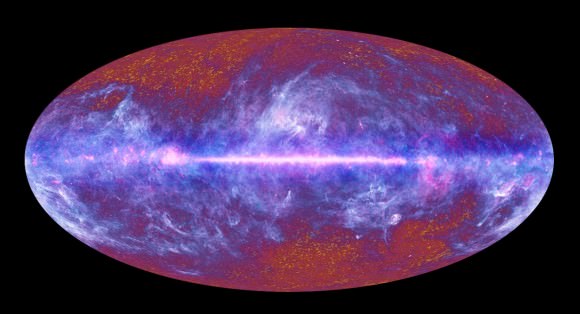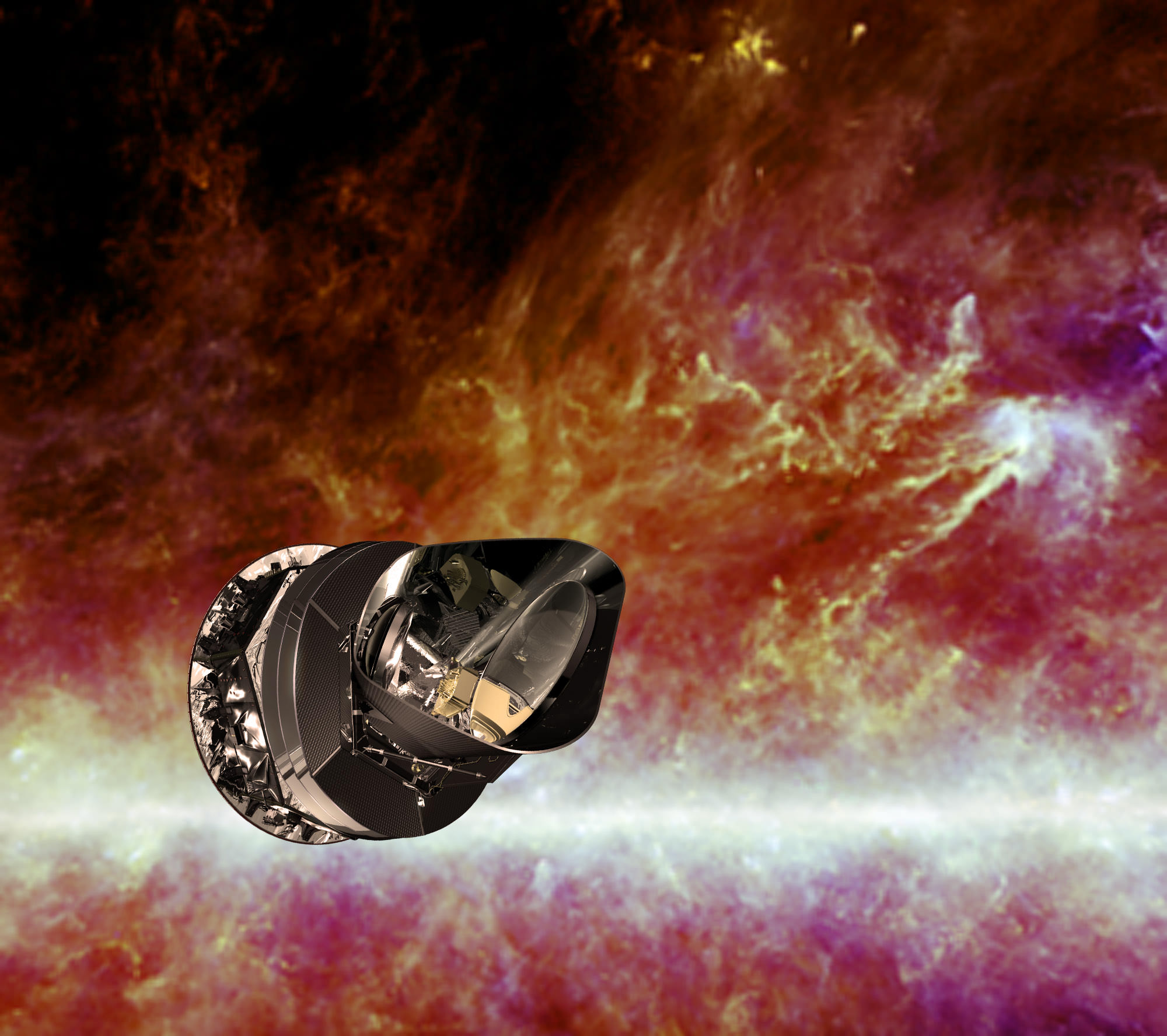[/caption]
After two and a half years of observing the Cosmic Microwave Background, the ESA Planck spacecraft’s High Frequency Instrument ran out of its on-board coolant gases over this past weekend, reaching the end of its very successful mission. But that doesn’t mean the end for Planck observations. The Low Frequency Instrument, which does not need to be super-cold (but is still at a bone-chilling -255 C), will continue taking data.
“The Low Frequency Instrument will now continue operating for another year,” said Richard Davis, of the University of Manchester in the UK. “During that time it will provide unprecedented sensitivity at the lower frequencies.”
From its location at the Earth/Sun’s L2 Lagrangian point, Planck was designed to ‘see’ the microwaves from the CMB and detects them by measuring temperature. The expansion of the Universe means that the CMB is brightest when seen in microwave light, with wavelengths between 100 and 10,000 times longer than visible light. To measure such long wavelengths Planck’s detectors have to be cooled to very low temperatures. The colder the spacecraft, the lower the temperatures the spacecraft can detect.
The High Frequency Instrument (HFI) was cooled to as close to 2.7K (about –270°C, near absolute zero) as possible.
Planck worked perfectly for 30 months, about twice the span originally required, and completed five full-sky surveys with both instruments.
“Planck has been a wonderful mission; spacecraft and instruments have been performing outstandingly well, creating a treasure trove of scientific data for us to work with,” said Jan Tauber, ESA’s Planck Project Scientist.
While it was the combination of both instruments that made Planck so powerful, there is still work for the LFI to do.

The scientists involved in Planck have been busy understanding and analyzing the data since Planck launched in May 2009. Initial results from Planck were announced last year, and with Planck data, scientists have created a map of the CMB identifying which bits of the map are showing light from the early Universe, and which parts are due to much closer objects, such as gas and dust in our galaxy, or light from other galaxies. The scientists have also produced a catalog of galaxy clusters in the distant Universe — many of which had not been seen before — and included some gigantic ‘superclusters,’ which are probably merging clusters.
The scientists expect to release data about star formation later next month, and reveal cosmological findings from the Big Bang and the very early Universe in 2013.
“The fact that Planck has worked so perfectly means that we have an incredible amount of data,” said George Efstathiou, a Planck Survey Scientist from the University of Cambridge. “Analyzing it takes very high-performance computers, sophisticated software, and several years of careful study to ensure that the results are correct.”
Source: ESA, UK Space Agency


So vast is the volume of data from this successful mission to be sorted that the entire mission information content will not be released until 2014.
Fun fact from the ESA web-page on L2 the second Lagrangian point:
“Since Lagrangian points are produced by the ‘balance’ of two or more opposing forces, it is possible that artificial Lagrangian points could be created by spacecraft if they could constantly produce a force to counteract the pull of gravity. Giant reflective sails, known as Solar sails, could do this by using the Sun’s light to push, they would allow spacecraft to ‘hover’ almost anywhere they wanted in space, rather than being forced to move constantly through an orbit.”
L2 is located 1.5 million kilometers directly behind the Earth as viewed from the Sun. Lagrangian Points are named after the French mathematician Joseph Louis de Lagrange (1736-1813) who discovered there are 5 points dotted around the 2 larger masses in which all the forces acting on the small one cancel each other out. 3 of the points lie on the line joining the two massive bodies: L1 lies between them, while L2 and L3 have the two bodies between them.
These three points are unstable, slight displacements of a body from them resulting in its rapid departure. The fourth and fifth points (L4 and L5) each form an equilateral triangle with the two massive bodies, 60 degrees ahead of and behind the smaller body in its orbit around the larger one.
So vast is the volume of data from this successful mission to be sorted that the entire mission information content will not be released until 2014.
Fun fact from the ESA web-page on L2 the second Lagrangian point:
“Since Lagrangian points are produced by the ‘balance’ of two or more opposing forces, it is possible that artificial Lagrangian points could be created by spacecraft if they could constantly produce a force to counteract the pull of gravity. Giant reflective sails, known as Solar sails, could do this by using the Sun’s light to push, they would allow spacecraft to ‘hover’ almost anywhere they wanted in space, rather than being forced to move constantly through an orbit.”
L2 is located 1.5 million kilometers directly behind the Earth as viewed from the Sun. Lagrangian Points are named after the French mathematician Joseph Louis de Lagrange (1736-1813) who discovered there are 5 points dotted around the 2 larger masses in which all the forces acting on the small one cancel each other out. 3 of the points lie on the line joining the two massive bodies: L1 lies between them, while L2 and L3 have the two bodies between them.
These three points are unstable, slight displacements of a body from them resulting in its rapid departure. The fourth and fifth points (L4 and L5) each form an equilateral triangle with the two massive bodies, 60 degrees ahead of and behind the smaller body in its orbit around the larger one.
Egads, more delays! I was prompted to check on the date of the next Planck data release but yesterday, and lazily checked with the Wikipedia page that said “end of 2012”. It still does, so I managed to squeeze in between updates.
Well, *now* I know. It is a slight delay to “early 2013” and the mission extension makes another worthwhile wait. Waiting for CMB data is like being slowly cooked in a low power microwave oven. :-/